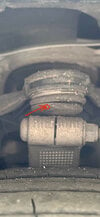I tried the fix suggested with grease and syringes and it completely eliminate the squeaking after one drive around the neighborhood. Total cost: $30 and enough leftover to do it 8 more times before I need new needles.
I bought all from Amazon:
Syringe and needles 14Ga
Wheel Bearing Grease in a tub
J-B Weld Silicone Sealant
1. You can access the ball joint without removing the tire quite easily. I just cleaned the area and adjusted the rubber a little to find a good spot to inject in the area that the red arrow pointed to in the first post.
2. Take the plunger without the needle and insert into the grease tub and slowly pull straight up to fill. After you get 10 ml, screw on the needle.
3. Hold close to the needle and push into the rubber boot.
4. Slowly push the syringe until you empty the syringe. I moved the needle around a little bit to deposit it in different spots.
5. Pull the needle out and if some doesn't come oozing out, maybe inject some more.
6. Work the grease in by pushing down numerous times on the fender. I could immediately hear the squeak get quieter on each push. Once no more squeak, take it for a drive an make a lot of turns. Go through some bumpy parking lots or roads.
7. Clean grease off the area. Use the J-B Weld and blot a small amount in the area and spread with finger (I was wearing latex gloves). This should be left to cure for 24 hours.
I noticed when grease was oozing out from the hole that the original grease looked light brown and thin. It's only been a day but the problem is completely gone.



